Aldwell-Schachter Chapter 17
Click on a musical example for playback
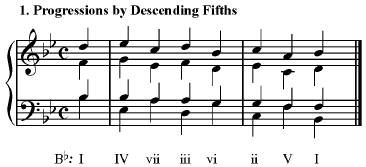 This is a complete progression of descending fifths. Note that some of the fifths appear as ascending fourths in order to keep the bass within a reasonable register. Also note the doubled leading tone in the root position vii. This would appear to violate chord-construction and syntactical rules about using root-position diminished chords. However, it does none of these: the leading tone isn’t leading, and the sequential nature of the progression has auditory precedence over other considerations.
This is a complete progression of descending fifths. Note that some of the fifths appear as ascending fourths in order to keep the bass within a reasonable register. Also note the doubled leading tone in the root position vii. This would appear to violate chord-construction and syntactical rules about using root-position diminished chords. However, it does none of these: the leading tone isn’t leading, and the sequential nature of the progression has auditory precedence over other considerations.
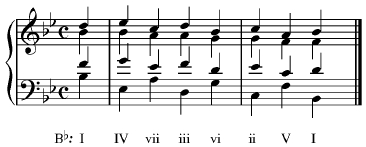
This is the same progression, but using a slightly different voice leading. Again note the doubled leading tone in the root-position vii, but remember that it isn’t really the leading tone in this case—it’s just ^7.
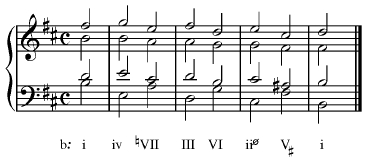
In minor keys, the same progression requires the use of natural VII in order to avoid an awkward movement, but it does employ the normal major V (with the raised leading tone) for the final cadence. Also note the use of ii—it’s a root-position diminished triad. The sequential pattern is more compelling than the unsatisfactory nature of root-position diminished triads.

Here a progression in descending fifths is used to form the final cadence for a chorale progression.
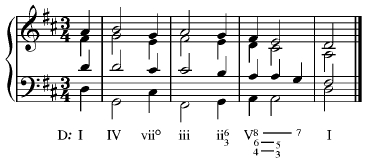
A partial descending fifths progression is here used as the opening. Notice that the mediant triad is used as the stopping point, then the progression moves through a ii6 on the way to its final cadence.
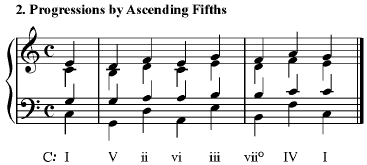
A complete progression of ascending fifths is useless, given that the chords prior to the final tonic do not establish I as a goal. Especially awkward is the motion from vii to IV.
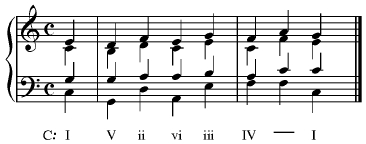
In this example, the diminished vii is replaced with IV, which breaks the progression of ascending fifths and makes it useful. Note that part of the original progression—I V ii vi iii—is quite useful.
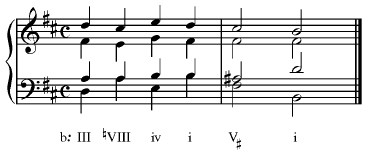
Only part of an ascending fifths progression in minor keys is useful. This example shows that an ascending fifths progression can make a strong motion from III – V. Also note that the first measure, taken by itself and not in the context of the following cadence, sounds clearly as though it is in D Major, the relative major to B Minor.
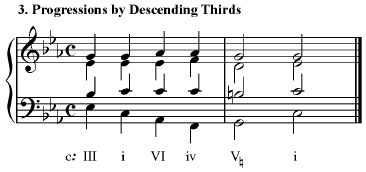
This progression demonstrates the use of descending thirds connecting III to iv in minor keys.
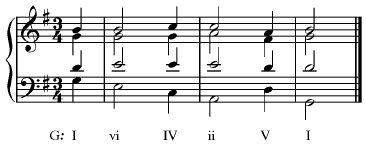
This progression demonstrates the use of descending thirds to connect I and ii in major keys.
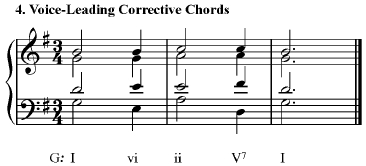
It is often possible to break up a forbidden parallel motion by interposing a chord between the two offending chords. Here a submediant is inserted between I and ii in order to break up the parallel fifths and octaves. Other chords may also be used for this purpose, but one must be careful. The vi works well because it stands in a clear relationship with the following ii—both chords are predominant, and the root motion between the predominants is downwards. In other words, voice-leading corrective chords must respect normal functional relationships.
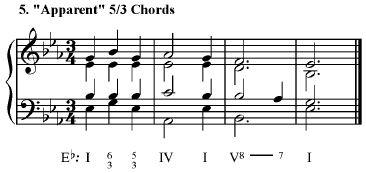
An “apparent” chord is a chord which looks like a duck but doesn’t quack like one. The I in measure 2 is an apparent tonic—it is supporting a passing tone in the soprano, and has no real function of its own. Note that it is on a weak beat, which is typical of apparent chords of all kinds.
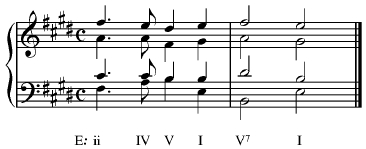
This is an apparent IV (eighth notes) supporting a passing ^1 in the soprano. As in the above example, the apparent chord occurs on a weak beat.
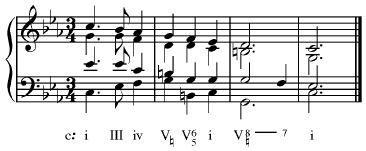
Similar to the above example, this is an apparent III supporting a passing natural ^7 in the soprano, also on a weak beat.

In this example, V moves to vi twice. The first time (measure 1), minor v moves to VI. Note that natural ^7 is supported in the soprano. The second time (measure 2) natural ^7 is not being supported in the soprano, and major V moves to VI, in a traditional deceptive cadence.